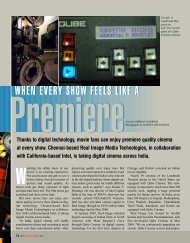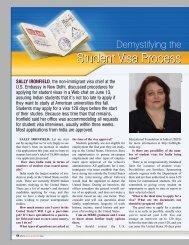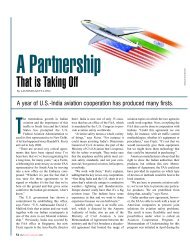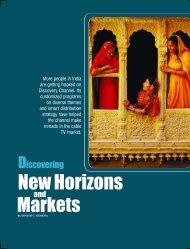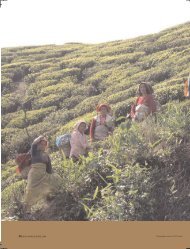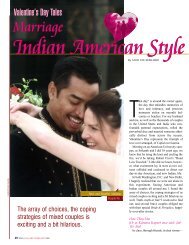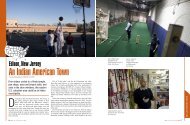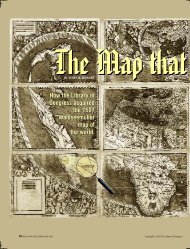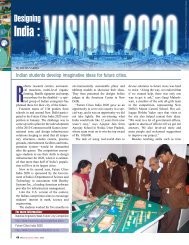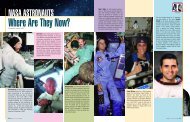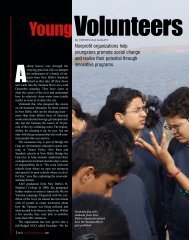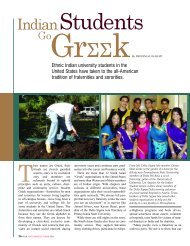2-3 Mike Interview.qxd
2-3 Mike Interview.qxd
2-3 Mike Interview.qxd
Create successful ePaper yourself
Turn your PDF publications into a flip-book with our unique Google optimized e-Paper software.
Helping Our Peoples Connect<br />
Indians and Americans connect through learning about each other’s music, languages, history, cultural<br />
practices, society and art; buying each other’s products, attending each other’s universities, teaching,<br />
visiting each other, helping in time of need, and working together to prevent the spread of disease<br />
and disaster. SPAN celebrates these connections in this issue, beginning with a farewell interview<br />
from Publisher Michael H. Anderson, who has worked to foster mutual understanding as U.S.<br />
Embassy Minister Counselor for Public Affairs. Anderson, a former journalist and teacher, and a 25year<br />
veteran of the U.S. Foreign Service, is transferring to the U.S. Embassy in Jakarta, Indonesia.<br />
After four years as head of the<br />
Embassy’s all-India press, culture and<br />
educational affairs, what’s your take<br />
on U.S.-India relations?<br />
Like many American diplomats in<br />
India, I’ve had the privilege of two,<br />
separate postings in this remarkable country.<br />
From 1987-90, I was the Embassy’s<br />
spokesman/information officer. Then I<br />
came back in 2002 to serve in the postliberalized,<br />
“new” India. Relations between<br />
our two countries are the best they<br />
have ever been. Secretary of State Condoleezza<br />
Rice put it nicely when she said:<br />
“India is an increasingly important partner<br />
for the United States, and we welcome<br />
its emergence as a global power in<br />
the 21st century.”<br />
Our two governments, and an increasingly<br />
wider range of both of our peoples,<br />
realize that the development of a strategic<br />
partnership is a “win-win” for both countries.<br />
That’s why President George W.<br />
Bush made his historic visit to India in<br />
March and why there’s been such acceleration<br />
in our cooperation. Indians and<br />
Americans are interacting as never before<br />
and across a wide spectrum of activities—not<br />
just civil nuclear issues but also<br />
on trade, defense, tourism, health and<br />
education. As two great multicultural<br />
democracies, we realize as never before<br />
that it is in our mutual interest to work<br />
closer together on the great challenges of<br />
these times—anti-terrorism, regional<br />
security, trade and investment, energy, the<br />
environment, HIV/AIDS, human trafficking,<br />
UN reform and other concerns.<br />
Have you had any disappointments<br />
in India?<br />
2 SPAN JULY/AUGUST 2006<br />
Michael Anderson interacts with rescued<br />
street children at Janaseva Sisu Bhavan in<br />
Aluva, Kerala, in March 2005.<br />
Not personally, but professionally as a<br />
diplomat and as someone who believes in<br />
greater international people-to-people contact.<br />
For example, I’d like to see much<br />
more international educational cooperation<br />
to help both countries adapt to a changing<br />
world. There are dozens of top-notch,<br />
accredited American universities which<br />
are eager to work with India, but the<br />
opportunities just aren’t there yet and welcoming<br />
policies aren’t in place. I would<br />
hope that sooner rather than later the<br />
Indian government would come out with<br />
clear policies that would foster more educational<br />
exchange, joint research and other<br />
kinds of Indo-U.S. academic cooperation.<br />
We all know that India has more students<br />
in the United States—80,466 last year—<br />
than any other country. We really need to<br />
work on getting more American scholars<br />
to experience and learn from India so<br />
there’s not such an imbalance in the flow<br />
of students between our two countries.<br />
What specifically might India do to<br />
attract more American scholars?<br />
The research clearance and visa<br />
issuance processes could be greatly speeded<br />
up. Indian universities and bodies like<br />
the University Grants Commission, the<br />
All India Council for Technical Education<br />
and the Association of Indian Universities<br />
could more actively market and promote<br />
Indian higher education opportunities to,<br />
and in, America. Facilities—from dormitories<br />
and canteens to publications and<br />
Web sites to libraries and labs—could be<br />
greatly improved to draw more foreigners<br />
to India. American students would certainly<br />
pay to have the chance to study in India,<br />
CHRISTOPHER WURST
ut they won’t come in any significant<br />
numbers until infrastructure improves and<br />
policies are much clearer and more welcoming.<br />
While many countries are moving<br />
rapidly to reform higher education and<br />
make it world-class, India seems to be<br />
hesitating and sending out mixed signals.<br />
With Indian university seats in such<br />
short supply, why should India bother<br />
with trying to recruit foreigners?<br />
To be more globally competitive, India<br />
needs to attract the world’s “best and<br />
brightest” and exchange ideas and research<br />
with leading educational institutions from<br />
around the world. India can no longer<br />
afford to be cut off from the benefits of<br />
international education, which promotes<br />
not only mutual understanding and new<br />
knowledge, but also practical science and<br />
technology, business, agricultural, social<br />
science and other “spin-offs” that can help<br />
improve people’s lives and promote a<br />
knowledge-based, more modern economy.<br />
Many good things are going on between<br />
our universities, including the new<br />
Agricultural Knowledge Initiative launched<br />
by President Bush and Prime Minister<br />
Manmohan Singh. But much, much more<br />
can, and should, be done. Our bilateral educational<br />
cooperation is just starting, and I<br />
think the time is right to dramatically<br />
expand all kinds of partnerships between<br />
Indian and American universities, both<br />
public and private. There’s no reason why<br />
India shouldn’t be both importing and<br />
exporting teaching, training and research<br />
services. The needs are clearly there and<br />
growing, and the mobility of scholars and<br />
everyone else is on the rise.<br />
Much of your work has involved<br />
dealing with the Indian media. How do<br />
you assess their performance?<br />
Like the American press, of course, the<br />
Indian press is feisty and free, and I’ve not<br />
always agreed with their coverage, but I<br />
respect their independence and have<br />
observed a rise in professionalism.<br />
Especially in terms of production qualities,<br />
the Indian media have come very far<br />
in just the past few years. Unlike the<br />
American media, India’s lucky to be very<br />
much in a media growth mode—with new<br />
TV channels, FM stations, various publications<br />
in different languages and formats<br />
and online services popping up all over. In<br />
the United States, journalists are very worried<br />
that the daily newspaper and even our<br />
four major broadcast networks may eventually<br />
become irrelevant as cable TV and<br />
Internet become ever more dominant as<br />
news and entertainment providers. I do<br />
worry that part of the Indian press has<br />
become highly sensationalized and overly<br />
“page three” oriented. These same trends<br />
are seen in the United States.<br />
As responsible citizens, I think we all<br />
need to make sure our young people<br />
acquire the reading habit and keep up on<br />
current affairs at home and abroad. As the<br />
world shrinks, that’s more important than<br />
ever because what happens in the United<br />
States affects India and what happens in<br />
India affects the United States. Whether<br />
it’s Wall Street or Dalal Street,<br />
Hollywood or Bollywood, oil prices or<br />
wheat prices, the world is increasingly<br />
interdependent, and we simply must stay<br />
well informed if we are to maintain our<br />
Michael Anderson congratulates Saatvik<br />
Agarwal, a student from Amity<br />
International School, Saket, New Delhi, who<br />
was chosen in November 2003 to participate<br />
in a NASA Mars exploration project at the<br />
Jet Propulsion Laboratory in California.<br />
Stanford University recently awarded<br />
Agarwal a scholarship to study there.<br />
respective democracies and promote<br />
peace and security. One encouraging<br />
recent development that has impressed<br />
me in India is the passage of the important<br />
Right to Information Act. This farreaching<br />
legislation is along the lines of<br />
America’s Freedom of Information Act,<br />
and I think its speedy implementation will<br />
greatly empower the average Indian citizen<br />
and contribute to a more transparent,<br />
responsive government.<br />
What’s happening at the American<br />
Centers in India?<br />
The American Centers in New Delhi,<br />
Mumbai, Calcutta and Chennai are actively<br />
engaged in what we call “public diplomacy”<br />
activities, striving to explain American<br />
policies and values and society in all their<br />
diversity and to engage with a wide range of<br />
Indians. We do that in a variety of ways,<br />
including cultural programs, speakers,<br />
films, workshops and seminars, often in<br />
partnership with Indian organizations. We<br />
try to foster an exchange of ideas on timely<br />
issues as diverse as HIV/AIDS, environmental<br />
protection, economic reform,<br />
nuclear proliferation and biotechnology.<br />
Since more than half of the Indian people<br />
are under 25, we want to reach out to young<br />
people. Through our Hindi and Urdu editions<br />
of SPAN we are trying to do a better<br />
job communicating with non-English<br />
speaking audiences. In addition to our<br />
excellent public access libraries, which we<br />
now call American Information Resource<br />
Centers, we recently established an English<br />
language teaching program, and we work<br />
closely with the U.S. Educational<br />
Foundation in India (USEFI) to promote<br />
Fulbright and other exchange programs and<br />
to provide advising services to help students<br />
pursue higher education in the United<br />
States. CONNECTIONS<br />
SPAN JULY/AUGUST 2006 3<br />
Courtesy Amity International School



